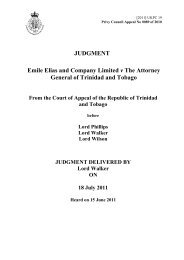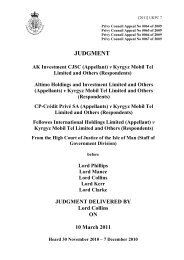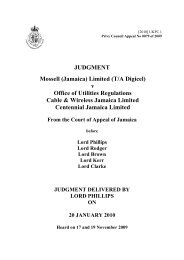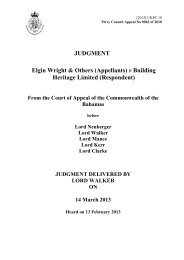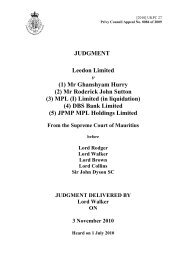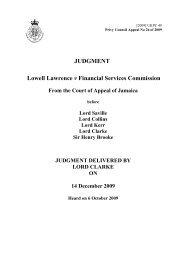Terrell Neilly v The Queen - Judicial Committee of the Privy Council
Terrell Neilly v The Queen - Judicial Committee of the Privy Council
Terrell Neilly v The Queen - Judicial Committee of the Privy Council
Create successful ePaper yourself
Turn your PDF publications into a flip-book with our unique Google optimized e-Paper software.
[2012] UKPC 12<br />
<strong>Privy</strong> <strong>Council</strong> Appeal No 0112 <strong>of</strong> 2010<br />
JUDGMENT<br />
<strong>Terrell</strong> <strong>Neilly</strong> v <strong>The</strong> <strong>Queen</strong><br />
From <strong>the</strong> Court <strong>of</strong> Appeal <strong>of</strong> <strong>the</strong> Commonwealth <strong>of</strong> <strong>the</strong><br />
Bahamas<br />
before<br />
Lord Hope<br />
Lord Mance<br />
Lord Dyson<br />
Lord Sumption<br />
Sir Stanley Burnton<br />
JUDGMENT DELIVERED BY<br />
SIR STANLEY BURNTON<br />
ON<br />
10 May 2012<br />
Heard on 20-21 March 2012
Appellant<br />
David Farrer QC<br />
Jonathan Bertram<br />
(Instructed by S J Berwin<br />
LLP)<br />
Respondent<br />
Howard Stevens<br />
(Instructed by Charles<br />
Russell LLP)
SIR STANLEY BURNTON:<br />
Introduction<br />
1. This is ano<strong>the</strong>r case in which <strong>the</strong> admissibility <strong>of</strong> a dock identification falls to<br />
be considered.<br />
2. On 18 October 1999, <strong>the</strong> Appellant was convicted, by a majority verdict <strong>of</strong> 10<br />
to 2, <strong>of</strong> 10 counts <strong>of</strong> armed robbery and <strong>of</strong> one count <strong>of</strong> possession <strong>of</strong> a firearm with<br />
intent to endanger life. On 25 October 1999, he was sentenced to 20 years’<br />
imprisonment on each count <strong>of</strong> robbery, to run concurrently, and to 5 years’<br />
imprisonment for <strong>the</strong> firearms <strong>of</strong>fence, to be served consecutively. He was given leave<br />
to appeal against <strong>the</strong> robbery convictions. His appeal against those convictions to <strong>the</strong><br />
Court <strong>of</strong> Appeal <strong>of</strong> <strong>the</strong> Commonwealth <strong>of</strong> <strong>The</strong> Bahamas (Zacca P, Churaman and<br />
Ganpatsingh JJA) was dismissed on 7 September 2000. It was not until 13 December<br />
2010 that his notice <strong>of</strong> appeal to <strong>the</strong> <strong>Judicial</strong> <strong>Committee</strong> <strong>of</strong> <strong>the</strong> <strong>Privy</strong> <strong>Council</strong> was<br />
filed. Special leave was granted on 15 March 2011 and his appeal heard on 20 March<br />
2012.<br />
<strong>The</strong> facts<br />
3. During <strong>the</strong> evening <strong>of</strong> 15 January 1998, two men committed an armed robbery<br />
at <strong>the</strong> Comfort Zone Restaurant, New Providence, Bahamas. It was <strong>the</strong> prosecution’s<br />
case that <strong>the</strong> Appellant was one <strong>of</strong> <strong>the</strong> two men involved. One <strong>of</strong> <strong>the</strong>m was armed<br />
with what was described as an Uzi-type automatic firearm; <strong>the</strong> o<strong>the</strong>r had a shiny or<br />
chrome handgun.<br />
4. On 17 January 1998, outside a house in Haven Road, Nassau Village or<br />
Redland Acres <strong>the</strong> Appellant was arrested with Roland Cartwright and Devaughn<br />
Rolle for <strong>the</strong> armed robbery at <strong>the</strong> restaurant. It was <strong>the</strong> prosecution’s case that during<br />
<strong>the</strong> course <strong>of</strong> <strong>the</strong> arrest, <strong>the</strong> Appellant fired at <strong>the</strong> arresting police <strong>of</strong>ficers as <strong>the</strong>y<br />
approached him. It was <strong>the</strong> Appellant’s case that <strong>the</strong> <strong>of</strong>ficers fired at him without<br />
provocation and that he did not return fire. <strong>The</strong> Appellant sustained injuries from what<br />
occurred during <strong>the</strong> arrest and he required hospital treatment. Upon arrest, <strong>the</strong><br />
Appellant was found in possession <strong>of</strong> a silver and black handgun and two items <strong>of</strong><br />
jewellery, which were later identified as items stolen during <strong>the</strong> robbery. O<strong>the</strong>r items<br />
stolen in <strong>the</strong> robbery were also found in <strong>the</strong> house.<br />
5. An identification parade was held on 17 January 1998. Both Cartwright and<br />
Rolle participated. <strong>The</strong> Appellant was <strong>the</strong>n in hospital, being treated for <strong>the</strong> injuries he<br />
Page 2
had suffered when he was arrested. Six witnesses to <strong>the</strong> robbery attended <strong>the</strong> parade.<br />
Two <strong>of</strong> <strong>the</strong>m identified Cartwright as one <strong>of</strong> <strong>the</strong> robbers. <strong>The</strong>y did not identify Rolle.<br />
<strong>The</strong> o<strong>the</strong>r witnesses who attended <strong>the</strong> parade made no identification.<br />
6. <strong>The</strong> Appellant was discharged from hospital on 27 January 1998. When told<br />
that he was suspected <strong>of</strong> <strong>the</strong> armed robbery at <strong>the</strong> Comfort Zone Restaurant he denied<br />
<strong>the</strong> <strong>of</strong>fence, saying that he had been “in <strong>the</strong> back <strong>of</strong> South Beach in Farmer Brown<br />
yard all night”. He did not <strong>the</strong>reafter participate in any identification parade.<br />
7. <strong>The</strong> Appellant, Cartwright and Rolle were jointly charged with ten counts <strong>of</strong><br />
armed robbery at <strong>the</strong> Restaurant on 15 January 1998, contrary to section 360 (2) <strong>of</strong> <strong>the</strong><br />
Penal Code <strong>of</strong> <strong>the</strong> Commonwealth <strong>of</strong> <strong>the</strong> Bahamas (counts 1-10). <strong>The</strong> Appellant was<br />
also charged with one count <strong>of</strong> possession <strong>of</strong> a firearm with intent to endanger life on<br />
17 January 1998, contrary to Section 23 <strong>of</strong> <strong>the</strong> Firearms Act (count 11) and two counts<br />
<strong>of</strong> receiving stolen property between 15 January 1998 and 17 January 1998, contrary<br />
to section 379 <strong>of</strong> <strong>the</strong> Penal Code <strong>of</strong> <strong>the</strong> Commonwealth <strong>of</strong> <strong>The</strong> Bahamas (counts 12<br />
and 15). <strong>The</strong> receiving counts were alternatives to <strong>the</strong> armed robbery counts.<br />
8. <strong>The</strong> Appellant and his co-defendants were tried before <strong>the</strong> Supreme Court<br />
between 5 May 1999 and 11 May 1999. This trial was aborted when two jurors were<br />
discharged for personal reasons and <strong>the</strong> judge discharged <strong>the</strong> remainder and directed<br />
that <strong>the</strong>re should be a retrial. <strong>The</strong> second trial, to which we shall simply refer as “<strong>the</strong><br />
trial”, took place between 4 and 18 October 1999.<br />
<strong>The</strong> trial<br />
(a) <strong>The</strong> admission <strong>of</strong> <strong>the</strong> dock identification<br />
9. At <strong>the</strong> trial, before Allen J and a jury, <strong>the</strong> prosecution called a number <strong>of</strong><br />
witnesses who had been present when <strong>the</strong> robberies were committed. No one<br />
purported to identify <strong>the</strong> Appellant, o<strong>the</strong>r than Larry Fernander. Mr Fernander had not<br />
been invited to attend any identification parade. He testified that one <strong>of</strong> <strong>the</strong> robbers,<br />
<strong>the</strong> man with <strong>the</strong> machine gun, had taken his bracelet, which was one <strong>of</strong> <strong>the</strong> items<br />
recovered from <strong>the</strong> house in Haven Road, toge<strong>the</strong>r with his wallet and mobile<br />
telephone. He had had a view <strong>of</strong> his face, and could recognise him if he saw him<br />
again.<br />
10. Counsel for <strong>the</strong> Appellant objected to any attempt at a dock identification. <strong>The</strong><br />
witness and <strong>the</strong> jury withdrew while submissions were made as to whe<strong>the</strong>r <strong>the</strong> dock<br />
identification should be permitted. Counsel for <strong>the</strong> Appellant submitted that to allow<br />
<strong>the</strong> witness, who had not previously identified anyone or even indicated that he could<br />
Page 3
do so, to purport to identify one <strong>of</strong> three persons in <strong>the</strong> dock, would be inconsistent<br />
with <strong>the</strong> authority <strong>of</strong> <strong>the</strong> Court <strong>of</strong> Appeal in Sheldon Alleyne v R Case No. 50 <strong>of</strong> 1989.<br />
Counsel accepted that a dock identification was legally admissible, and that <strong>the</strong> judge<br />
had a discretion to exclude it if she felt that <strong>the</strong> effect would be more prejudicial than<br />
probative. He submitted that <strong>the</strong> dock identification, if admitted, would be more<br />
prejudicial than probative, and should be excluded.<br />
11. Counsel for Rolle informed <strong>the</strong> judge that in <strong>the</strong> previous aborted trial, <strong>the</strong><br />
witness had not identified anyone. That he said he could do so was new. He said that<br />
<strong>the</strong> judge could take judicial notice <strong>of</strong> this. <strong>The</strong> judge said she could not do so, since<br />
she did not know, among o<strong>the</strong>r things, what <strong>the</strong> witness had been asked at that trial.<br />
12. Counsel for <strong>the</strong> prosecution was unable to say why Mr Fernander had not been<br />
given <strong>the</strong> opportunity to attend an identification parade. His submissions focused on<br />
<strong>the</strong> opportunity <strong>the</strong> witness had had to observe <strong>the</strong> robbers, and his witness statement<br />
to <strong>the</strong> effect he would be able to recognise one <strong>of</strong> <strong>the</strong>m. He did not refer to <strong>the</strong> risk<br />
that <strong>the</strong> witness would identify one <strong>of</strong> <strong>the</strong> defendants simply because he was in <strong>the</strong><br />
dock.<br />
13. Giving her ruling, <strong>the</strong> judge said:<br />
“I am going -- I'm satisfied that <strong>the</strong> parameters which are set in <strong>the</strong> case<br />
<strong>of</strong> R v Turnbull have been laid. I am going to allow, in my discretion,<br />
<strong>the</strong> dock identification by Mr. Fernander <strong>of</strong> <strong>the</strong> person whom he says<br />
held <strong>the</strong> Uzi or <strong>the</strong> machine gun, and whom he said he observed for two<br />
to three minutes, and whom he said was at one point close - as close as<br />
two feet away from him. I am going to, as I said, exercise my discretion<br />
and allow <strong>the</strong> dock identification , for what it’s worth.”<br />
14. Mr Fernander and <strong>the</strong> jury <strong>the</strong>n came back into court. He <strong>the</strong>n said that <strong>the</strong><br />
robber whom he could identify was <strong>the</strong> man with <strong>the</strong> hand gun. <strong>The</strong> witness <strong>the</strong>n<br />
identified <strong>the</strong> Appellant as <strong>the</strong> man with <strong>the</strong> chrome hand gun. He was shown <strong>the</strong> hand<br />
gun recovered when <strong>the</strong> Appellant was arrested, and said that it looked very much like<br />
<strong>the</strong> gun used in <strong>the</strong> robbery. However, in cross examination Mr Fernander reverted to<br />
saying that <strong>the</strong> man he had identified was <strong>the</strong> man with <strong>the</strong> machine gun.<br />
15. <strong>The</strong> prosecution called a number <strong>of</strong> police <strong>of</strong>ficers who gave evidence relating<br />
to, among o<strong>the</strong>r things, <strong>the</strong> shooting, arrest and subsequent searches <strong>of</strong> <strong>the</strong> house in<br />
Haven Road and <strong>of</strong> <strong>the</strong> defendants. Detective Constable Nixon gave evidence that<br />
when he and o<strong>the</strong>r <strong>of</strong>ficers arrived at <strong>the</strong> house <strong>the</strong> Appellant pulled out a silver<br />
handgun, pointed it in his direction and fired several shots, and that he returned fire.<br />
Constable Farrington likewise gave evidence that <strong>the</strong> Appellant opened fire and that<br />
Page 4
he took cover and returned fire. Sergeant Hinzey gave evidence that he searched <strong>the</strong><br />
Appellant and seized a number <strong>of</strong> items. <strong>The</strong>se included items which were <strong>the</strong> subject<br />
<strong>of</strong> count 12, one <strong>of</strong> <strong>the</strong> counts <strong>of</strong> receiving.<br />
16. Inspector Melvin Lundy gave evidence regarding <strong>the</strong> identification parade held<br />
on 17 January 1998 and <strong>the</strong> identification <strong>of</strong> Roland Cartwright by two witnesses. <strong>The</strong><br />
Appellant had been in hospital and did not participate in <strong>the</strong> identification parade.<br />
17. Finally <strong>the</strong> prosecution called Clement Paul (also known as Farmer Brown). Mr<br />
Paul gave evidence that he had seen Mr Rolle in his yard on <strong>the</strong> night <strong>of</strong> <strong>the</strong> robbery,<br />
but that he had not seen <strong>the</strong> Appellant.<br />
(b) <strong>The</strong> submission <strong>of</strong> no case<br />
18. Following <strong>the</strong> close <strong>of</strong> <strong>the</strong> prosecution case, counsel for all three defendants<br />
submitted that <strong>the</strong>re was no case to answer. Counsel for <strong>the</strong> Appellant relied on <strong>the</strong><br />
weakness <strong>of</strong> <strong>the</strong> identification evidence, and <strong>the</strong> well-known authority <strong>of</strong> Galbraith.<br />
Rejecting <strong>the</strong> submission on behalf <strong>of</strong> <strong>the</strong> Appellant, <strong>the</strong> judge said:<br />
“With respect to <strong>Terrell</strong> Neely, I simply find <strong>the</strong> evidence <strong>of</strong> a sufficient<br />
quality to safely leave to <strong>the</strong> jury to assess. I am satisfied that all <strong>of</strong> <strong>the</strong><br />
factors which Turnbull says ought to be present are present, and I am<br />
going to leave that evidence to <strong>the</strong>m. I accept that <strong>the</strong>re is one witness<br />
that <strong>the</strong> identification was not tested on identification parade, however, I<br />
am satisfied that in <strong>the</strong> circumstances that <strong>the</strong>re was a good reason for<br />
not holding <strong>the</strong> ID parade for Neely. In addition to that, <strong>the</strong>re is <strong>the</strong><br />
evidence <strong>of</strong> recent possession <strong>of</strong> some <strong>of</strong> <strong>the</strong> goods allegedly stolen<br />
which may support <strong>the</strong> correctness <strong>of</strong> <strong>the</strong> identification by Mr.<br />
Fernander. In <strong>the</strong> circumstances, I find that <strong>Terrell</strong> Neely has a case to<br />
answer on <strong>the</strong> counts <strong>of</strong> robbery and I am going to leave those to <strong>the</strong><br />
jury for <strong>the</strong>ir consideration.”<br />
19. However, <strong>the</strong> judge upheld <strong>the</strong> submission made on behalf <strong>of</strong> Nolle, and<br />
withdrew <strong>the</strong> counts charging him with armed robbery from <strong>the</strong> jury. <strong>The</strong> counts <strong>of</strong><br />
receiving remained against him, and one <strong>of</strong> those counts, count 12 remained against<br />
<strong>the</strong> Appellant also.<br />
20. <strong>The</strong> Appellant gave alibi evidence. He denied having a gun or firing it at <strong>the</strong><br />
police on 17 January 1998, and contended that <strong>the</strong> gun and <strong>the</strong> stolen property had<br />
been planted on him by <strong>the</strong> police. He called one witness in support <strong>of</strong> his alibi.<br />
Page 5
(c) <strong>The</strong> summing up<br />
21. During <strong>the</strong> course <strong>of</strong> <strong>the</strong> summing up, <strong>the</strong> judge withdrew from <strong>the</strong> jury <strong>the</strong><br />
count charging <strong>the</strong> Appellant and Cartwright with receiving stolen goods, saying that<br />
she was doing so “For <strong>the</strong> sake <strong>of</strong> fairness and clarity and to avoid any confusion”. It<br />
seems that she did so without informing counsel <strong>of</strong> her intention to do so or seeking<br />
<strong>the</strong>ir submissions.<br />
22. <strong>The</strong> judge gave an unexceptional Turnbull direction, directing <strong>the</strong> jury to<br />
consider carefully <strong>the</strong> evidence as to <strong>the</strong> identifying witnesses’ sightings <strong>of</strong> <strong>the</strong><br />
persons <strong>the</strong>y purported to identify during <strong>the</strong> course <strong>of</strong> <strong>the</strong> robbery. She <strong>the</strong>n<br />
addressed <strong>the</strong> identification evidence <strong>of</strong> Mr Fernander. She said:<br />
“With respect to <strong>the</strong> identification evidence, I must point out to you just<br />
one weakness in <strong>the</strong> evidence <strong>of</strong> Larry Fernander, and that is that he did<br />
not attend an ID parade, and so his ability to identify <strong>the</strong> accused person<br />
from a number <strong>of</strong> o<strong>the</strong>r persons was not, in fact, tested.<br />
Now, it is usual that <strong>the</strong>re is an ID parade if <strong>the</strong> police feel that it's<br />
necessary. You recall in this case <strong>the</strong> fact was that Neely was<br />
hospitalized, and that his evidence here is from <strong>the</strong> 17th to <strong>the</strong> 27th.<br />
Whe<strong>the</strong>r that is a reasonable explanation or not is a question for you.<br />
But you, at <strong>the</strong> end <strong>of</strong> <strong>the</strong> day, must determine whe<strong>the</strong>r you are sure that<br />
<strong>the</strong> evidence <strong>of</strong> Larry Fernander in relation to <strong>the</strong> identification <strong>of</strong> Mr.<br />
Neely was correct. That is <strong>the</strong> weakness.<br />
Now, if, after considering all <strong>of</strong> <strong>the</strong>se matters which I have indicated to<br />
you, you conclude that <strong>the</strong> quality <strong>of</strong> <strong>the</strong> ID evidence is good, <strong>the</strong>n you<br />
may convict on that evidence alone, notwithstanding that you find it is<br />
not supported by any o<strong>the</strong>r evidence, and provided you warn yourselves<br />
<strong>of</strong> <strong>the</strong> danger.<br />
Now, as I've said, <strong>the</strong>re’s o<strong>the</strong>r evidence which is capable <strong>of</strong> supporting<br />
that evidence. If you decide that that evidence is not -- you don't accept<br />
that evidence, <strong>the</strong>n you are left only with <strong>the</strong> evidence <strong>of</strong> identification<br />
by those three witnesses. And, in any event, you must be careful when<br />
you come to consider that identification evidence.<br />
I also remind you that this matter is alleged to have happened some 20<br />
months ago, and you’re going to have to make allowances for <strong>the</strong> fact<br />
that with <strong>the</strong> passage <strong>of</strong> time memories do fade, and witnesses cannot be<br />
Page 6
expected to remember with crystal clarity what has happened 20 months<br />
ago.”<br />
23. <strong>The</strong> judge reminded <strong>the</strong> jury <strong>of</strong> <strong>the</strong> evidence <strong>of</strong> Mr Fernander:<br />
“He told you he did not attend an ID parade, but he identified Mr Neely<br />
as <strong>the</strong> man who took his bracelet, wallet and radio and <strong>the</strong> man who had<br />
<strong>the</strong> chrome gun, <strong>the</strong> chrome gun. You recall later he said that he as<br />
wrong about that. That <strong>the</strong> man was <strong>the</strong> man with <strong>the</strong> machine gun, <strong>the</strong><br />
man he identified was <strong>the</strong> man with <strong>the</strong> machine gun as he had first said<br />
in his examination in chief. So it’s a question for you. He did say on two<br />
occasions that it was <strong>the</strong> man with <strong>the</strong> machine gun that he observed and<br />
identified. He later said it was <strong>the</strong> man with <strong>the</strong> shiny gun, <strong>the</strong>n<br />
corrected that to say it was, in fact <strong>the</strong> man with <strong>the</strong> machine gun. It’s a<br />
question for you.”<br />
24. As mentioned above, <strong>the</strong> jury, by a majority, convicted <strong>the</strong> Appellant <strong>of</strong> <strong>the</strong><br />
robberies.<br />
<strong>The</strong> judgment <strong>of</strong> <strong>the</strong> Court <strong>of</strong> Appeal<br />
25. It is not clear from <strong>the</strong> judgment <strong>of</strong> <strong>the</strong> Court <strong>of</strong> Appeal to what extent <strong>the</strong><br />
objection to <strong>the</strong> dock identification <strong>of</strong> <strong>the</strong> Appellant was pressed before <strong>the</strong>m. <strong>The</strong><br />
only issue that is specifically mentioned in <strong>the</strong>ir judgment was whe<strong>the</strong>r <strong>the</strong> judge’s<br />
withdrawing <strong>of</strong> <strong>the</strong> count <strong>of</strong> receiving stolen goods from <strong>the</strong> jury rendered <strong>the</strong>ir<br />
verdicts on <strong>the</strong> robbery counts unsafe.<br />
<strong>The</strong> contentions before <strong>the</strong> Board<br />
26. On behalf <strong>of</strong> <strong>the</strong> Appellant, Mr Farrer submitted:<br />
a) <strong>The</strong> judge had erred in law in allowing <strong>the</strong> dock identification<br />
to be adduced before <strong>the</strong> jury.<br />
b) <strong>The</strong> judge erred in rejecting <strong>the</strong> submission on behalf <strong>of</strong> <strong>the</strong><br />
Appellant that <strong>the</strong>re was no case to answer.<br />
c) <strong>The</strong> judge should not have withdrawn <strong>the</strong> counts <strong>of</strong> receiving<br />
from <strong>the</strong> jury.<br />
Page 7
d) <strong>The</strong> summing up <strong>of</strong> <strong>the</strong> identification evidence against <strong>the</strong><br />
Appellant was inadequate.<br />
e) It followed that <strong>the</strong> convictions for armed robbery were<br />
unsafe, and <strong>the</strong>y should be quashed.<br />
27. For <strong>the</strong> prosecution, Mr Stevens submitted:<br />
a) <strong>The</strong> judge was entitled, in <strong>the</strong> exercise <strong>of</strong> her discretion, to<br />
allow <strong>the</strong> dock identification to go before <strong>the</strong> jury.<br />
b) She was similarly entitled to reject <strong>the</strong> submission on behalf <strong>of</strong><br />
<strong>the</strong> Appellant at <strong>the</strong> close <strong>of</strong> <strong>the</strong> prosecution case.<br />
c) <strong>The</strong> withdrawal <strong>of</strong> <strong>the</strong> count <strong>of</strong> receiving stolen property did<br />
not affect <strong>the</strong> safety <strong>of</strong> <strong>the</strong> convictions for armed robbery.<br />
d) While he accepted that <strong>the</strong> direction to <strong>the</strong> jury was<br />
inadequate, on <strong>the</strong> evidence as a whole <strong>the</strong> convictions for<br />
robbery were safe; <strong>the</strong> Board should apply <strong>the</strong> proviso and <strong>the</strong><br />
appeal should <strong>the</strong>refore be dismissed.<br />
Discussion<br />
Dock identifications<br />
28. When considering <strong>the</strong> admissibility, and <strong>the</strong> strength, <strong>of</strong> identification<br />
evidence, it is <strong>of</strong>ten necessary to consider separately <strong>the</strong> circumstances in which <strong>the</strong><br />
witness saw <strong>the</strong> accused and <strong>the</strong> circumstances in which he later identified him. <strong>The</strong><br />
well-known judgment <strong>of</strong> <strong>the</strong> Court <strong>of</strong> Appeal <strong>of</strong> England and Wales in R v Turnbull<br />
[1977] QB 224 addresses <strong>the</strong> former circumstances. <strong>The</strong> directions that <strong>the</strong> Court <strong>of</strong><br />
Appeal mandated must be given to a jury concern those circumstances: in o<strong>the</strong>r words<br />
<strong>the</strong> duration and <strong>the</strong> conditions <strong>of</strong> <strong>the</strong> witness’s observation <strong>of</strong> <strong>the</strong> <strong>of</strong>fender during or<br />
around <strong>the</strong> time <strong>of</strong> <strong>the</strong> <strong>of</strong>fence. Turnbull itself, <strong>the</strong> first <strong>of</strong> <strong>the</strong> appeals considered by<br />
<strong>the</strong> Court <strong>of</strong> Appeal, was a case <strong>of</strong> recognition <strong>of</strong> Turnbull by a police <strong>of</strong>ficer. Both <strong>of</strong><br />
<strong>the</strong> o<strong>the</strong>r appellants whose cases were before <strong>the</strong> Court, Roberts and Whitby, had been<br />
identified in identification parades. None<strong>the</strong>less, <strong>the</strong>ir convictions were quashed<br />
because <strong>the</strong> circumstances in which <strong>the</strong> <strong>of</strong>fenders had been seen by <strong>the</strong> identifying<br />
witnesses were not such as to give confidence as to <strong>the</strong> reliability <strong>of</strong> <strong>the</strong><br />
identifications, and in this sense <strong>the</strong> quality <strong>of</strong> <strong>the</strong> identifications was poor.<br />
Page 8
29. Issues as to <strong>the</strong> quality <strong>of</strong> a witness’s observation <strong>of</strong> an <strong>of</strong>fender, <strong>of</strong> <strong>the</strong> kind<br />
addressed in Turnbull, are relevant to dock identifications. In <strong>the</strong> case <strong>of</strong> dock<br />
identifications, however, <strong>the</strong>re is an added and separate need for caution, arising from<br />
<strong>the</strong> circumstances inherent in dock identification. <strong>The</strong> purpose <strong>of</strong> an identification<br />
parade is “to ensure that <strong>the</strong> identification <strong>of</strong> a suspect by a witness takes place in<br />
circumstances where <strong>the</strong> recollection <strong>of</strong> <strong>the</strong> identifying witness is tested objectively<br />
under safeguards by placing <strong>the</strong> suspect in a line made up <strong>of</strong> like-looking suspects”<br />
(Myvett and Santos v <strong>The</strong> <strong>Queen</strong> (unreported) 9 May 1994, Criminal Appeals Nos 3<br />
and 4 <strong>of</strong> 1994), cited in Pop v <strong>The</strong> <strong>Queen</strong> [2003] UKPC 40, in turn cited in<br />
Pipersburgh v <strong>The</strong> <strong>Queen</strong> [2008] UKPC 11, para 9.) <strong>The</strong> benefits <strong>of</strong> an identification<br />
parade and <strong>the</strong> weaknesses <strong>of</strong> a dock identification were summarised in Holland v HM<br />
Advocate [2005] UKPC D1, 2005 SC (PC) 1, 17, para 47:<br />
“…identification parades <strong>of</strong>fer safeguards which are not available when<br />
<strong>the</strong> witness is asked to identify <strong>the</strong> accused in <strong>the</strong> dock at his trial. An<br />
identification parade is usually held much nearer <strong>the</strong> time <strong>of</strong> <strong>the</strong> <strong>of</strong>fence<br />
when <strong>the</strong> witness’s recollection is fresher. Moreover, placing <strong>the</strong><br />
accused among a number <strong>of</strong> stand-ins <strong>of</strong> generally similar appearance<br />
provides a check on <strong>the</strong> accuracy <strong>of</strong> <strong>the</strong> witness’s identification by<br />
reducing <strong>the</strong> risk that <strong>the</strong> witness is simply picking out someone who<br />
resembles <strong>the</strong> perpetrator. Similarly, <strong>the</strong> Advocate-depute did not<br />
gainsay <strong>the</strong> positive disadvantages <strong>of</strong> an identification carried out when<br />
<strong>the</strong> accused is sitting in <strong>the</strong> dock between security guards: <strong>the</strong><br />
implication that <strong>the</strong> prosecution is asserting that he is <strong>the</strong> perpetrator is<br />
plain for all to see. When a witness is invited to identify <strong>the</strong> perpetrator<br />
in court, <strong>the</strong>re must be a considerable risk that his evidence will be<br />
influenced by seeing <strong>the</strong> accused sitting in <strong>the</strong> dock in this way. So a<br />
dock identification can be criticised in two complementary respects: not<br />
only does it lack <strong>the</strong> safeguards that are <strong>of</strong>fered by an identification<br />
parade, but <strong>the</strong> accused’s position in <strong>the</strong> dock positively increases <strong>the</strong><br />
risk <strong>of</strong> a wrong identification.”<br />
30. It follows that <strong>the</strong> fact that <strong>the</strong> circumstances <strong>of</strong> a witness’s identification <strong>of</strong> a<br />
person were such as to enable him to make a reliable identification in an identification<br />
parade does not render a dock identification by <strong>the</strong> witness reliable. As was pointed<br />
out by <strong>the</strong> Board in Pipersburgh at [15], <strong>the</strong> issues as to <strong>the</strong> sufficiency <strong>of</strong> a witness’s<br />
observation <strong>of</strong> a suspect are different from those as to <strong>the</strong> reliability <strong>of</strong> a dock<br />
identification.<br />
31. It fur<strong>the</strong>r follows that <strong>the</strong> normal and proper practice should be to hold an<br />
identification parade, and that in any case where a dock identification is admitted <strong>the</strong><br />
judge should warn <strong>the</strong> jury <strong>of</strong> <strong>the</strong> undesirability in principle and dangers <strong>of</strong> a dock<br />
identification and give fur<strong>the</strong>r directions along lines set out in Aurelio Pop v <strong>The</strong><br />
<strong>Queen</strong> [2003] UKPC 40, para 9, Pipersburgh v <strong>The</strong> <strong>Queen</strong> [2008] UKPC 11, para 9<br />
Page 9
and Tido v <strong>The</strong> <strong>Queen</strong> [2012] 1 WLR 115 [2011] UKPC 16, para 17, as to which see<br />
paragraph 35 below.<br />
32. <strong>The</strong> decision whe<strong>the</strong>r to admit dock identification evidence is one for <strong>the</strong> trial<br />
judge, to be exercised in <strong>the</strong> light <strong>of</strong> all <strong>the</strong> relevant circumstances. Ultimately <strong>the</strong><br />
question is one <strong>of</strong> fairness, bearing in mind <strong>the</strong> judge’s ability and duty to give<br />
appropriate directions in summing up, as indicated in <strong>the</strong> authorities referred to<br />
in <strong>the</strong> previous paragraph. Where <strong>the</strong>re has been no identification parade, <strong>the</strong>n<br />
whe<strong>the</strong>r <strong>the</strong>re is any and if so what good reason for that is a material circumstance.<br />
Where, for example, <strong>the</strong> uncontroversial evidence is that <strong>the</strong> defendant was well<br />
known to <strong>the</strong> witness before <strong>the</strong> <strong>of</strong>fence, and <strong>the</strong> witness has previously identified<br />
him, a dock identification may also be no more than a formality. Those were among<br />
<strong>the</strong> circumstances considered by <strong>the</strong> Board in Tido v <strong>The</strong> <strong>Queen</strong> [2012] 1 WLR 115<br />
[2011] UKPC 16 which might have favoured <strong>the</strong> admission <strong>of</strong> <strong>the</strong> dock identification:<br />
see at [23].<br />
<strong>The</strong> admission <strong>of</strong> <strong>the</strong> dock identification in this case<br />
33. <strong>The</strong> explanation for <strong>the</strong> failure to hold an identification parade may, as stated,<br />
be a relevant factor favouring <strong>the</strong> admission <strong>of</strong> a dock identification. In <strong>the</strong> present<br />
case, it was submitted by Mr Stevens that <strong>the</strong>re was a partial explanation for <strong>the</strong><br />
failure to hold an identification parade, in that <strong>the</strong> Appellant was in hospital when <strong>the</strong><br />
identification parade in relation to Cartwright and Rolle was held. However, this does<br />
not explain why no parade was held after <strong>the</strong> Appellant’s discharge from hospital in<br />
<strong>the</strong> 16 months between his discharge and <strong>the</strong> first trial, let alone <strong>the</strong> period between<br />
<strong>the</strong> two trials. In any event, his unavailability on 17 January 1998 could not render a<br />
dock identification any more reliable.<br />
34. <strong>The</strong> judge’s reasons for allowing <strong>the</strong> dock identification to go before <strong>the</strong> jury<br />
related entirely to <strong>the</strong> circumstances <strong>of</strong> <strong>the</strong> witness’s observation <strong>of</strong> <strong>the</strong> <strong>of</strong>fender<br />
during <strong>the</strong> robbery. She erred in considering that <strong>the</strong>re was a good reason for not<br />
holding an ID parade for <strong>the</strong> Appellant. She did not address <strong>the</strong> jury when summing<br />
up <strong>the</strong> risks <strong>of</strong> a mistaken dock identification and so may well not have had <strong>the</strong>se in<br />
mind when deciding to admit <strong>the</strong> dock identification. <strong>The</strong> only o<strong>the</strong>r evidence as to<br />
<strong>the</strong> Appellant’s involvement was consistent with his having been no more than a<br />
receiver: see paragraph 41 below. <strong>The</strong> judge thus erred materially in <strong>the</strong> exercise <strong>of</strong><br />
her discretion. <strong>The</strong> Board’s view is that a dock identification should have been<br />
regarded as inadmissible in all <strong>the</strong> circumstances <strong>of</strong> this case. <strong>The</strong> Board’s conclusion<br />
on <strong>the</strong> admissibility <strong>of</strong> <strong>the</strong> dock identification renders it unnecessary to consider <strong>the</strong><br />
Appellant’s contention that <strong>the</strong> robbery counts should in any event have been<br />
withdrawn from <strong>the</strong> jury at <strong>the</strong> conclusion <strong>of</strong> <strong>the</strong> prosecution case.<br />
Page 10
<strong>The</strong> summing up<br />
35. At para 21 <strong>of</strong> its judgment in Tido, <strong>the</strong> Board said:<br />
“…Where it is decided that <strong>the</strong> evidence [i.e., a dock identification] may<br />
be admitted, it will always be necessary to give <strong>the</strong> jury careful<br />
directions as to <strong>the</strong> dangers <strong>of</strong> relying on that evidence and in particular<br />
to warn <strong>the</strong>m <strong>of</strong> <strong>the</strong> disadvantages to <strong>the</strong> accused <strong>of</strong> having been denied<br />
<strong>the</strong> opportunity <strong>of</strong> participating in an identification parade, if indeed he<br />
has been deprived <strong>of</strong> that opportunity. In such circumstances <strong>the</strong> judge<br />
should draw directly to <strong>the</strong> attention <strong>of</strong> <strong>the</strong> jury that <strong>the</strong> possibility <strong>of</strong> an<br />
inconclusive result to an identification parade, if it had materialised,<br />
could have been deployed on <strong>the</strong> accused’s behalf to cast doubt on <strong>the</strong><br />
accuracy <strong>of</strong> any subsequent identification. <strong>The</strong> jury should also be<br />
reminded <strong>of</strong> <strong>the</strong> obvious danger that a defendant occupying <strong>the</strong> dock<br />
might automatically be assumed by even a well-intentioned eye-witness<br />
to be <strong>the</strong> person who had committed <strong>the</strong> crime with which he or she was<br />
charged.”<br />
36. Allen J did not have <strong>the</strong> benefit <strong>of</strong> <strong>the</strong> Board’s judgment in Tido, which<br />
considerably post-dates <strong>the</strong> trial. However, <strong>the</strong> dangers <strong>of</strong> a dock identification to<br />
which it refers have long been regarded as inherent in such evidence. <strong>The</strong> summing up<br />
was deficient in failing to warn <strong>the</strong> jury <strong>of</strong> <strong>the</strong> risks <strong>of</strong> <strong>the</strong> dock identification, as<br />
summarised in Tido.<br />
<strong>The</strong> withdrawal from <strong>the</strong> jury <strong>of</strong> <strong>the</strong> receiving count<br />
37. Mr Farrer relied on <strong>the</strong> judgment <strong>of</strong> <strong>the</strong> House <strong>of</strong> Lords in R v Coutts [2006]<br />
UKHL 39 [2006] 1 WLR 2154, in which <strong>the</strong> Appellant’s conviction for murder was<br />
quashed on <strong>the</strong> ground that <strong>the</strong> alternative murder <strong>of</strong> manslaughter should have been<br />
left to <strong>the</strong> jury. As a matter <strong>of</strong> fact, <strong>the</strong> Appellant in that case was retried and he was<br />
again convicted <strong>of</strong> murder. Coutts was considered by <strong>the</strong> Criminal Division <strong>of</strong> <strong>the</strong><br />
Court <strong>of</strong> Appeal <strong>of</strong> England and Wales in R v Foster [2007] EWCA Crim 2869 [2008]<br />
1 WLR 1615, which held that <strong>the</strong> principle in Coutts does not extend beyond <strong>the</strong><br />
ambit <strong>of</strong> <strong>the</strong> Criminal Law Amendment Act 1967. In a case such as <strong>the</strong> present, it is<br />
only necessary to section 6(3):<br />
“Where, on a person's trial on indictment for any <strong>of</strong>fence except treason<br />
or murder, <strong>the</strong> jury find him not guilty <strong>of</strong> <strong>the</strong> <strong>of</strong>fence specifically<br />
charged in <strong>the</strong> indictment, but <strong>the</strong> allegations in <strong>the</strong> indictment amount<br />
to or include (expressly or by implication) an allegation <strong>of</strong> ano<strong>the</strong>r<br />
<strong>of</strong>fence falling within <strong>the</strong> jurisdiction <strong>of</strong> <strong>the</strong> court <strong>of</strong> trial, <strong>the</strong> jury may<br />
Page 11
find him guilty <strong>of</strong> that o<strong>the</strong>r <strong>of</strong>fence or <strong>of</strong> an <strong>of</strong>fence <strong>of</strong> which he could<br />
be found guilty on an indictment specifically charging that o<strong>the</strong>r<br />
<strong>of</strong>fence.”<br />
38. <strong>The</strong> <strong>of</strong>fence <strong>of</strong> receiving is a true alternative to <strong>the</strong>ft or robbery. A person<br />
charged with an indictment alleging robbery cannot be convicted <strong>of</strong> receiving without<br />
a count alleging that <strong>of</strong>fence being added to <strong>the</strong> indictment, since receiving is by<br />
definition o<strong>the</strong>rwise than in <strong>the</strong> course <strong>of</strong> <strong>the</strong>ft. In o<strong>the</strong>r words, <strong>the</strong> charge <strong>of</strong> robbery<br />
does not include <strong>the</strong> charge <strong>of</strong> receiving, since it is not a case <strong>of</strong> <strong>the</strong> greater including<br />
<strong>the</strong> lesser, but <strong>of</strong> different <strong>of</strong>fences. It follows that under <strong>the</strong> law <strong>of</strong> England and<br />
Wales, in a case such as <strong>the</strong> present <strong>the</strong> trial judge could not have been required to<br />
direct <strong>the</strong> jury to convict <strong>of</strong> robbery if robbery were <strong>the</strong> only count before it. <strong>The</strong><br />
principle in Coutts has no application to this case.<br />
39. <strong>The</strong> Board agrees with <strong>the</strong> Court <strong>of</strong> Appeal that it was unwise <strong>of</strong> <strong>the</strong> judge to<br />
withdraw <strong>the</strong> count <strong>of</strong> receiving. However, if <strong>the</strong> evidence <strong>of</strong> <strong>the</strong> Appellant’s<br />
participation in <strong>the</strong> robbery had been sufficient for <strong>the</strong> jury to have convicted <strong>of</strong> that<br />
<strong>of</strong>fence, <strong>the</strong> Board would not have ruled <strong>the</strong> conviction unsafe by reason only <strong>of</strong> <strong>the</strong><br />
withdrawal <strong>of</strong> <strong>the</strong> receiving count. To do so would be tantamount to finding that <strong>the</strong><br />
jury did not comply with <strong>the</strong>ir oath and were not sure that <strong>the</strong> Appellant had been one<br />
<strong>of</strong> <strong>the</strong> robbers. <strong>The</strong>re would have been no justification for such a finding.<br />
<strong>The</strong> application <strong>of</strong> <strong>the</strong> proviso<br />
40. Mr Stevens submitted that notwithstanding <strong>the</strong> deficiencies in <strong>the</strong> trial referred<br />
to above, <strong>the</strong> Board could be sure that <strong>the</strong> jury would in any event have convicted <strong>the</strong><br />
Appellant. We cannot accept this submission. As pointed out above, apart from <strong>the</strong><br />
identification, <strong>the</strong> evidence against <strong>the</strong> Appellant was as consistent with his having<br />
been a receiver, assuming dishonesty, as with his being a robber. It is impossible to<br />
conclude that if <strong>the</strong>re had been no dock identification, or if <strong>the</strong> jury had been properly<br />
directed, <strong>the</strong> Appellant was bound to have been convicted.<br />
Conclusion<br />
41. For <strong>the</strong> reasons set out above, <strong>the</strong> conviction was unsafe. <strong>The</strong> Board will<br />
humbly advise Her Majesty that <strong>the</strong> appeal should be allowed and <strong>the</strong> conviction<br />
quashed.<br />
Page 12


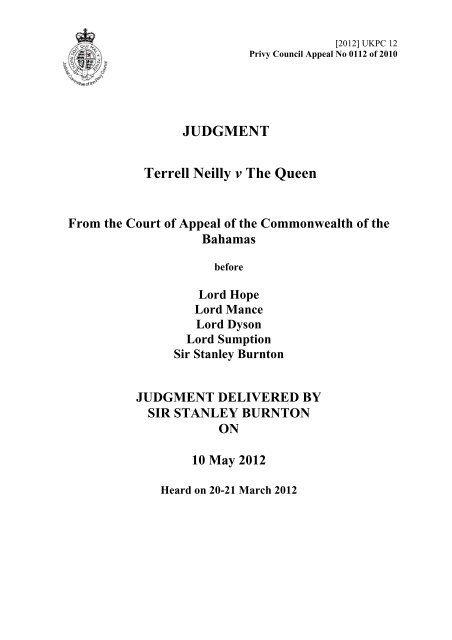
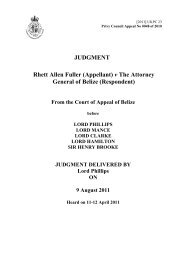

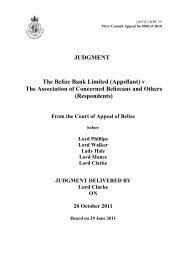
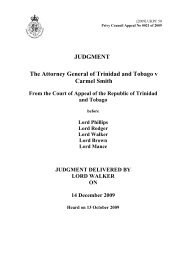
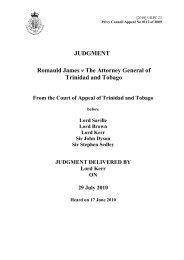
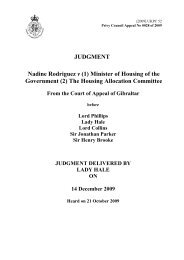
![[2011] UKPC 10 - Judicial Committee of the Privy Council](https://img.yumpu.com/23644185/1/184x260/2011-ukpc-10-judicial-committee-of-the-privy-council.jpg?quality=85)
